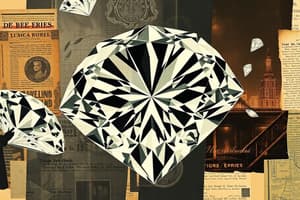Podcast
Questions and Answers
How does a traditional married woman view her identity in relation to her family?
How does a traditional married woman view her identity in relation to her family?
What priority does a modern married woman place on her responsibilities compared to her family?
What priority does a modern married woman place on her responsibilities compared to her family?
In what way does self-worth differ between traditional and modern married women?
In what way does self-worth differ between traditional and modern married women?
How does a traditional married woman feel about spending money on herself?
How does a traditional married woman feel about spending money on herself?
What is a key characteristic of modern married women's approach to personal spending?
What is a key characteristic of modern married women's approach to personal spending?
What demographic changes did De Beers target in East Asia during the mid-1980s?
What demographic changes did De Beers target in East Asia during the mid-1980s?
Why did De Beers open its first regional office in Hong Kong?
Why did De Beers open its first regional office in Hong Kong?
What role did May Wong play in De Beers' marketing strategy for Asia?
What role did May Wong play in De Beers' marketing strategy for Asia?
What was one of the main challenges De Beers faced when expanding into Asia?
What was one of the main challenges De Beers faced when expanding into Asia?
How did urbanization affect De Beers' marketing approach in East Asia?
How did urbanization affect De Beers' marketing approach in East Asia?
Why was there a need for surveys and market research by De Beers in Asia?
Why was there a need for surveys and market research by De Beers in Asia?
What differentiated Asian jewelry retailers from their Western counterparts according to De Beers?
What differentiated Asian jewelry retailers from their Western counterparts according to De Beers?
What did De Beers learn about pan-regional campaigns in the Asian market?
What did De Beers learn about pan-regional campaigns in the Asian market?
What was the primary reason the Rainshower advertisement was less effective in China compared to other regions in Asia?
What was the primary reason the Rainshower advertisement was less effective in China compared to other regions in Asia?
How did De Beers differentiate their marketing messages for modern and traditional women?
How did De Beers differentiate their marketing messages for modern and traditional women?
What strategy did De Beers employ to lower barriers for first-time diamond purchasers?
What strategy did De Beers employ to lower barriers for first-time diamond purchasers?
What percentage of diamond jewelry purchases in Asia were attributed to women's self-purchases?
What percentage of diamond jewelry purchases in Asia were attributed to women's self-purchases?
In South Korea, what unique market influenced diamond purchases, and what percentage of diamonds were bought for weddings?
In South Korea, what unique market influenced diamond purchases, and what percentage of diamonds were bought for weddings?
What was a critical feature of the Sparks advertisement that appealed to young women?
What was a critical feature of the Sparks advertisement that appealed to young women?
How did the ownership of one diamond influence future purchases according to De Beers' findings?
How did the ownership of one diamond influence future purchases according to De Beers' findings?
What two improvements did De Beers suggest to jewelry retailers to enhance the shopping experience?
What two improvements did De Beers suggest to jewelry retailers to enhance the shopping experience?
What was the annual market growth rate between 1993 and 1996?
What was the annual market growth rate between 1993 and 1996?
Which city was De Beers’ main market during this time?
Which city was De Beers’ main market during this time?
What was one of the consumer trends noted in the text that competed with luxury goods like diamonds?
What was one of the consumer trends noted in the text that competed with luxury goods like diamonds?
What advertising strategy did De Beers adopt for the Chinese market?
What advertising strategy did De Beers adopt for the Chinese market?
What new category of diamond purchasers did De Beers identify during its experience in Asia?
What new category of diamond purchasers did De Beers identify during its experience in Asia?
What challenge did De Beers face in the Japanese market?
What challenge did De Beers face in the Japanese market?
How did De Beers view the spending habits of women in Asia compared to those in the West?
How did De Beers view the spending habits of women in Asia compared to those in the West?
What marketing focus did Fiona Hindmarsh mention for the American market?
What marketing focus did Fiona Hindmarsh mention for the American market?
What was the primary criterion for judging success among the X-Generation according to the survey?
What was the primary criterion for judging success among the X-Generation according to the survey?
How did Chinese women's perspectives on marriage differ from traditional views of love?
How did Chinese women's perspectives on marriage differ from traditional views of love?
What role did peer admiration play in the lives of the X-Generation?
What role did peer admiration play in the lives of the X-Generation?
What were the traditional expectations of marriage roles among the X-Generation?
What were the traditional expectations of marriage roles among the X-Generation?
How did Chinese men feel about the financial expectations in regard to finding a wife?
How did Chinese men feel about the financial expectations in regard to finding a wife?
What was the dilemma faced by De Beers in introducing diamond rings in China?
What was the dilemma faced by De Beers in introducing diamond rings in China?
What view did both men and women in China have about marriage and love?
What view did both men and women in China have about marriage and love?
What were the trappings of wealth valued by the X-Generation?
What were the trappings of wealth valued by the X-Generation?
Why did Diane wonder about Emily's diamond ring?
Why did Diane wonder about Emily's diamond ring?
What was Diane's relationship with Emily before visiting Hong Kong?
What was Diane's relationship with Emily before visiting Hong Kong?
How did Emily perceive the purpose of her diamond ring compared to Diane?
How did Emily perceive the purpose of her diamond ring compared to Diane?
What does Diane’s eagerness to meet Emily's husband suggest about her character?
What does Diane’s eagerness to meet Emily's husband suggest about her character?
What cultural difference is illustrated by Emily's choice in wearing her wedding ring?
What cultural difference is illustrated by Emily's choice in wearing her wedding ring?
What can be inferred about the significance of weddings in Emily's culture?
What can be inferred about the significance of weddings in Emily's culture?
Why did Emily choose to wear the engagement ring on special occasions only?
Why did Emily choose to wear the engagement ring on special occasions only?
What does the term 'solitaire diamond pendant' reveal about Emily's tastes?
What does the term 'solitaire diamond pendant' reveal about Emily's tastes?
Flashcards
Diane's first travel
Diane's first travel
Emily's marriage
Emily's marriage
Emily's diamond ring
Emily's diamond ring
Western vs. Asian views
Western vs. Asian views
Solitaire diamond pendant
Solitaire diamond pendant
Hong Kong property developer
Hong Kong property developer
Middle-class Hong Kong Chinese background
Middle-class Hong Kong Chinese background
De Beers
De Beers
De Beers' Asian Strategy (1980s)
De Beers' Asian Strategy (1980s)
Motivations for Diamond Purchasing (Asia)
Motivations for Diamond Purchasing (Asia)
East Asian Consumer
East Asian Consumer
Regional Advertising (Asia)
Regional Advertising (Asia)
Cultural Bias in Surveys
Cultural Bias in Surveys
De Beers' East Asia Office (1994)
De Beers' East Asia Office (1994)
May Wong's role
May Wong's role
New vs. Old Money
New vs. Old Money
Asian wedding ring ads
Asian wedding ring ads
Rainshower ad
Rainshower ad
China's ad reaction
China's ad reaction
Wedding ring salary guideline
Wedding ring salary guideline
Women's desire message
Women's desire message
Sparks commercial
Sparks commercial
First-time diamond purchaser barriers
First-time diamond purchaser barriers
East & Southeast Asian sales
East & Southeast Asian sales
X-Generation Success Criteria
X-Generation Success Criteria
Chinese Marriage Motivation
Chinese Marriage Motivation
Traditional Marriage Roles (China)
Traditional Marriage Roles (China)
Love in China (1990s)
Love in China (1990s)
De Beers's China Diamond Dilemma
De Beers's China Diamond Dilemma
"Graveyard of Love"
"Graveyard of Love"
Marriage Expectations (Generation X)
Marriage Expectations (Generation X)
Diamond Rings in China (1996)
Diamond Rings in China (1996)
Traditional Married Woman
Traditional Married Woman
Modern Married Woman
Modern Married Woman
Self-Worth Validation (Traditional)
Self-Worth Validation (Traditional)
Self-Worth Validation (Modern)
Self-Worth Validation (Modern)
Spending Habits (Modern)
Spending Habits (Modern)
De Beers' Asian Market Strategy
De Beers' Asian Market Strategy
Market Growth Slowdown
Market Growth Slowdown
Emerging Consumer Spending
Emerging Consumer Spending
Advertising Budget Allocation
Advertising Budget Allocation
Shifting Diamond Purchasing Habits
Shifting Diamond Purchasing Habits
Western Market Adaptation
Western Market Adaptation
Challenges in Japan
Challenges in Japan
Changing 'Gift of Love' Message
Changing 'Gift of Love' Message
Study Notes
De Beers: Diamonds are for Asia
- This case study, written by Jocelyn Probert and Hellmut Schütte, is intended for classroom discussion, not as a guide to effective or ineffective administrative situations.
- The case centers on a situation where Diane, a visitor to Hong Kong, observes differences in diamond shopping habits in Asia versus those in Europe.
- Emily, Diane's friend, explains that diamonds are not worn every day, but as special gifts or tokens of love, usually on special occasions, and that it's more about value than daily wear.
- The case highlights the De Beers strategy of emphasizing the "gift of love" aspect in its marketing campaigns.
- De Beers maintains a Central Selling Organisation (CSO) to manage rough-diamond supply, limiting price fluctuations and building public trust.
- The CSO handles rough-diamond sorting into 14,000 categories based on the 4 Cs.
- De Beers' Consumer Marketing Division uses advertising campaigns to create demand for diamond jewellery.
- De Beers' marketing efforts targeted young Asian women as a priority.
The De Beers Story
- De Beers has marketed diamonds as the ultimate luxury product for centuries.
- Only 20% of mined diamonds are of gem quality, while the rest are industrial-grade stones.
- Smaller stones, near-gems, account for 30% of mined diamonds.
- The De Beers Central Selling Organisation (CSO) managed 65-70% of worldwide diamond production.
- The CSO has controlled production to maintain the luxury image of diamonds, even during economic downturns.
- De Beers' marketing focuses on "emotional" qualities.
- De Beers' efforts in Asia were focused on diamond engagement rings as the key to establish diamond purchase as a cultural custom.
Diamond Jewellery in Japan
- De Beers focused on the yuino ceremony which proved to be an enduring institution despite the decline of arranged marriages.
- The yuino ceremony was a traditional engagement ceremony.
- De Beers' strategy was to associate diamonds with the yuino custom, promoting diamonds as a meaningful symbol of future commitment.
- The initial advertisements for De Beers in Japan were less relevant to the local context and were adjusted after analysis of data and cultural observations.
- De Beers focused on a 'women's desire' campaign, which targeted women who wanted diamonds for self-purchase as a status symbol in a recession-proof sector.
Crisis in Asia
- The 1997–98 Asian financial crisis is highlighted as a period of reduced discretionary spending and altered market conditions for diamond consumption.
- The case emphasizes the difficulty in extrapolating experiences from one Asian market (China) to other markets.
- Variations across regions, lifestyles, and cultural norms were considered.
###Looking to the Future
- De Beers needed to adapt its marketing strategies to address variations in consumption attitudes amongst Asian consumers.
- De Beers needed to address the shift in priorities and expectations of younger generations of Asian women.
Studying That Suits You
Use AI to generate personalized quizzes and flashcards to suit your learning preferences.




